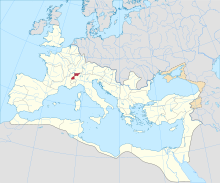| Provincia Alpes Graiae et vallis Poenina Provincia Alpes Atrectianae et vallis Poenina | |||||||
|---|---|---|---|---|---|---|---|
| Province of the Roman Empire | |||||||
| 41/54 AD–476 | |||||||
 The Roman Empire c. 125 AD, with the province of Alpes Graiae et Poeninae highlighted | |||||||
| Capital | Forum Claudii Ceutronum (Alpes Graiae/Atrectianae) Forum Claudii Vallensium (Alpes Poeninae) | ||||||
| Historical era | Antiquity | ||||||
• Created by Claudius | 41/54 AD | ||||||
• Deposition of Romulus Augustulus | 476 | ||||||
| |||||||
| Today part of | France Italy Switzerland | ||||||
The Alpes Graiae et Poeninae, later known as Alpes Atrectianae et Poeninae (officially Alpes Atrectianae et Vallis Poenina), was a small Alpine province of the Roman Empire created after the merging of the Alpes Poeninae (or Vallis Poenina) and the Alpes Graiae (or Alpes Atrectianae), probably during the reign of Claudius (41–54 AD). Comprising the modern Canton of Valais (Switzerland), the Tarantaise Valley (France), and the Aosta Valley (Italy), it was one of the three provinces straddling the Alps between modern France and Italy, along with the Alpes Maritimae and Alpes Cottiae.
The province had two capitals, most likely since its creation: Forum Claudii Ceutronum (modern-day Aime-la-Plagne) for the Alpes Graiae, and Forum Claudii Vallensium (modern-day Martigny) for the Alpes Poeninae.[1][2] The procurator of the province resided alternatively in one of the two chief towns.[1]
- ^ a b Wiblé 1998, pp. 186–188.
- ^ Cite error: The named reference
OssenkopWinkelmannwas invoked but never defined (see the help page).